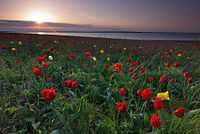Zangezi

 Cover picture by painter Pyotr Miturich (signed П. М. - Пётр Митурич). The first edition of Zangezi. 1922[1] | |
| Author | Velimir Khlebnikov |
|---|---|
| Cover artist | Pyotr Miturich |
| Publication place | Soviet Russia |
Zangezi (Russian: Зангези), or Zangezi: A Supersaga in 20 Planes, is a futurist poem-play by Soviet, poet, writer and scholar Velimir Khlebnikov.
Title and history
[edit]Zangezi is the name of a prophet in the work, the name being composed from Kalmyk word 'zyange', that in Kalmyk language means "messenger".[2][3]
The name Zangezi had different variants in Velimir Khlebnikov's draft book (which he was ironically calling in German fashion 'Großbuch'): Zengezi, Mangezi, Changezi, Changili (Зенгези, Мангези, Чангези, Чангили). Some critics said the name Zangezi associated with famous rivers Ganges and Zambezi.[4] Other pointed out that Zangezi is name composed from Kalmyk word 'zyange', that in Kalmyk language means 'the messenger'.[2]
Velimir Khlebnikov wrote to his friend, fellow futurist poet Vasily Kamensky in 1909, that he had wanted to create a work in which 'every chapter must not have a likeness of another' ('...каждая глава не должна походить на другую...'), wanted in the work 'with the generosity of a beggar, throwing all his paints and discoveries on the palette' ('...с щедростью нищего бросить на палитру все свои краски и открытия...').[1]

It is thought that the work was completed in January, 1922, when Velimir Khlebnikov had written in his diaries on January 16, 1922: 'Zangezi gathered-solved'. Literary critics Nikolay Stepanov (Николай Леонидович Степанов) and Yury Tynyanov thought that different parts of Zangezi were written between 1920 and 1922. Pyotr Miturich (Пётр Васильевич Митурич), a painter and who helped his friend Velimir Khlebnikov to edit the printed texts when the author was ill and powerless, helped to prepare the work for publication when the author died. He painted the cover of the first publication (see picture above).[5]
The first edition of Zangezi was published in July 1922, but Khlebnikov didn't see the publication because had died a few weeks earlier on June 28, 1922, from what some sources said was malaria.[6] Avant-garde painter Vladimir Tatlin staged the play Zangezi on May 23, 1923 in the Petrograd Museum of Feature Art, in a production where cultural researcher Nikolay Punin and poet Georgy Yakubovsky read lectures before the play began. Tatlin constructed in the play a mechanism for connecting prophet Zangezi with masses, and the stage was decorated with 'star language graphemes'.[1]
Some cultural critics praised the play, while others said (such as Sergey Yutkevich, who would later become a well-known Soviet screenwriter) it was very badly staged.[1]
Plot
[edit]
The prophet Zangezi lives among wildlife, mountains, birds, trees, grasses, gods. Zangezi speaks significant words, but human beings are ignorant to understand him:
Мне, бабочке, залетевшей
| To me, a butterfly, flown |
Velimir Khlebnikov and Futurism
[edit]
Velimir Khlebnikov invented new words in the play: birds language, words of sky, and 'beyonsense'.[3]
There once was an occasion, when Velimir Khlebnikov said that he didn't belong to Futurism; that is why the literary critic Yury Tynyanov underlined, that he 'not accidentally ... was calling himself the Budetlyanin (a Russian pun, meaning 'a Future Living Being'), not a Futurist, and not accidentally that term was not held' ('...не случайно... называл себя будетлянином (не футуристом), и не случайно не удержалось это слово').[7][1]
See also
[edit]References
[edit]- ^ a b c d e Оборин, Лев. "ВЕЛИМИР ХЛЕБНИКОВ, ЗАНГЕЗИ. 1922" (in Russian).
- ^ a b "Картина с выставки: Серафим Александрович Павловский (1903-1989), Зангези едет в город. 1968. К 115-летию со дня рождения". Астраханская картинная галерея имени П.М.Догадина (in Russian).
- ^ a b Gussow, Mel (November 24, 1987). "Stage: 'Zangezi,' Russian Futurism at Next Wave". The New York Times. Archived from the original on November 2, 2017.
- ^ Велимир Хлебников. Творения / Общая редакция и вступительная статья М. Я. Полякова; Составление, подготовка текста и комментарии В. П. Григорьева и А. Е. Парниса (in Russian). — М.: Советский писатель, 1986.
Имени Зангези сопутствовали вар. Зенгези, Мангези, Чангези, Чангили («Гроссбух»). Это «говорящее» имя-символ, принципиальное для героя (образ которого сливается с образом автора), контаминирует назв. рек — Ганга и Замбези как символы Евразии и Африки. [Name Zangezi accompanied with variants Zengesi, Mangezi, Changesi, Changili ("Großbuch"). This "speaking" name-symbol, which is fundamental for the hero (whose image merges with the image of the author), connects the names of rivers - Ganges and Zambezi as symbols of Eurasia and Africa.]
- ^ a b "Примечания". Собрание произведений Велимира Хлебникова. Том 3. Стихотворени 1917-1922 / Под общей ред. Ю. Тынянова и Н. Степанова (in Russian). Ленинград: Издательство писателей в Ленинграде. 1931.
"Зангези" собранрешен 16 января 1922 года.
- ^ "Хлебников Велимир". Издательство «Директ-Медиа» (in Russian).
- ^ Тынянов Ю. Н. (2000). О Хлебникове; Мир Велимира Хлебникова: Статьи. Исследования (1911–1918) (in Russian). Москва: Языки русской культуры.
External links
[edit]- YouTube; poems by Velimir Khlebnikov read by Roman Jacobson/Стихи Велимира Хлебникова читает Роман Якобсон
- Biography about Rudolf Abikh, Orientalist, Iranist, Velimir Khlebnikov's friend on the website Our Baku / Абих Рудольф Петрович - востоковед, иранист, репрессирован; Наш Баку